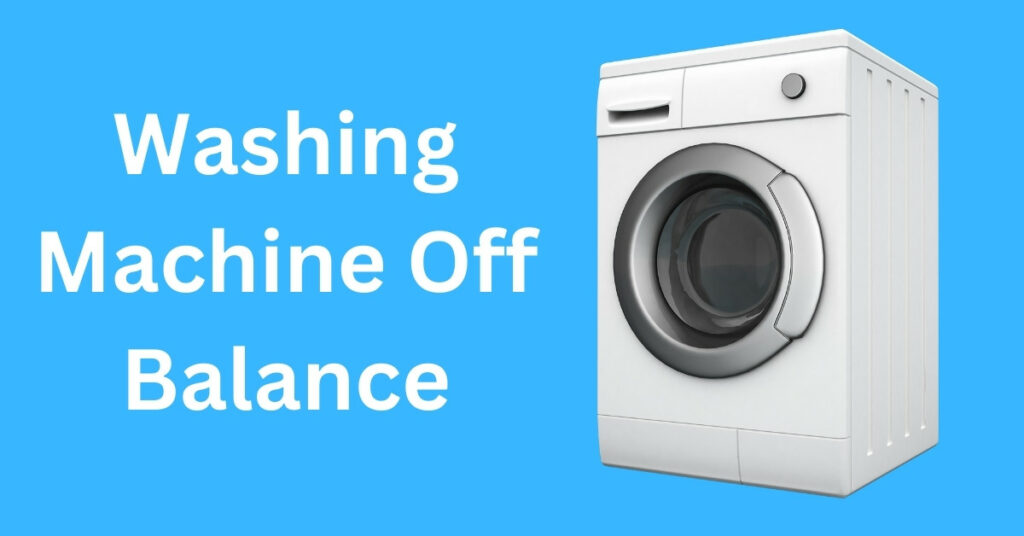Washing machines can go off-balance if there is a leveling issue. Also, laundry stuck in the washer drum and agitator can cause balance issues.
An imbalanced washer is nothing short of a disaster. While it may only look scary, it can cause problems if left unchecked.
Since a washer spins at an incredible speed, it needs to be on a flat and leveled surface to avoid toppling over. You must place your washing machine on a flat surface with every side balanced adequately.
However, sometimes the problems may persist, and the risk of toppling may also remain. To find out troubleshooting methods, you need to read this article below.
In this article, I have defined the common reasons for a washer to go off balance. I have also included solutions to these problems to help you solve them at home.
Why Does A Washer Go Off Balance?

A washer can go off balance for several reasons. In most cases, it may be an alignment problem or stuck debris in the washer drum.
Having an imbalanced washer can be scary and annoying. The water will rotate aggressively during the spin cycle, and minor problems may make it imbalanced.
To fix this issue, you need to understand the root of the problem. Here are some top reasons why your washer may be off balance.
1. Improper Leveling
Leveling issues are the most common reason your washer is going off balance. A washing machine spins at high speed during the rinse part.
If you keep it on a carpeted surface, it can easily get off-balance. Additionally, floor tiles, at times, may crack and cause problems for your washer.
Please ensure no laundry or a foreign object is stuck under the machine, making it go off balance. Additionally, your washer may have an internal balance problem that can be fixed at home.
2. Overloading
Overloading the washing machine is another common mistake that people frequently make. When a device is overloaded, it might get thrown off balance during the spin cycle.
To check this problem, you must ensure the overload warning has not gone off. Additionally, check if the problem persists when with a smaller load.
Always make sure you leave some space when loading a top-load washer. Remember that clothes will become heavier when they are soaked.
3. Stuck Laundry Or Debris
Laundry can often get stuck below or between the agitator and the inner tub. This blockage can make the washer have problems with balance.
Even pieces of debris like broken chains, coins, zips, etc. can cause the washer to become off balance. You will then need to remove the agitator, and the debris or laundry stuck in the drum.
To avoid this issue from recurring, you need to check all your pockets for forgotten stuff. Also, avoid machine-washing delicate clothing that might rip off and get stuck.
4. Forgotten Shipping Bolts
Sometimes shipping materials may be accidentally left in place. When a washing machine goes to its destination, it is usually bolted to avoid transit damage.
A top-load washer will have a single shipping bolt installed on the bottom and some on the back of the washer. You need to find all these bolts and remove them before putting them to use.
You will find all information on shipping bolts in the washer manual. When assembling and installing it yourself, read this manual carefully.
How To Fix An Unbalanced Washing Machine?
You can quickly fix an unbalanced washer by finding the root of the problem. In the following steps, you need to do minor maintenance work to ensure the issue is gone for good.
No matter what the cause of the problem is, the correct methods can fix an unbalanced washer at home. Here are some of the troubleshooting steps that will help you solve this problem.
1. Realign Washer
Top-loading washers can be adjusted by tipping the washer forward, then placing it back on the floor. Front-loading washers might require you to open the front access panel to control the legs of the washer.
2. Remove Stuck Laundry
If you suspect that laundry is stuck in the machine, you need to remove the front or top panel and the agitator and remove the culprit items. Simply unscrew the connecting bolts to remove the panels.
3. Take Out Excess Laundry
When a machine is overloaded, stop the wash cycle and take out the excess clothing.
4. Remove Shipping Bolts
Before installing a washer, carefully read the manual for information about shipping bolts and remove them before use. Check the manual again if you had forgotten them during installation.
5. Check the Flooring
If you have been keeping your washer in a carpeted room, consider shifting it elsewhere where the floor is more leveled.
How Much Does It Cost To Fix An Unbalanced Washing Machine?
It doesn’t take a lot of money to fix an imbalanced washer. The highest possible charge can be $50; however, in most cases, you can just remove excess or stuck clothing and level out the washer correctly by yourself.
From what I’ve seen, you may not need to spend a single buck to fix an imbalanced washer. However, you can call a professional for help if the problem is stuck debris.
They might charge you $50 or more for the work. You can look up tutorials and solve the problem at zero cost to avoid this charge.
My advice would be to try and get it fixed yourself. The troubleshooting steps are pretty simple, and no rocket science is involved.
Many people may be uncomfortable removing the control panel and the agitator. In that case, you can hire a professional or ask a friend who knows their way around machines.
Is It Worth Fixing A Washing Machine?
The feasibility of fixing a washing machine depends on the damaged parts. Usually, it is worth fixing a device if the repair costs fall within $80.
A washing machine can cost anywhere from $200-400, depending on the brand and model. When you compare the prices, it’s better to have your washer repaired before you give it up for good.
If the age of your washing machine is more than ten years, I suggest upgrading and buying a newer model. With an old model, finding parts can be quite challenging.
Also, old models can keep having problems since washing machines are not meant to be everlasting. Additionally, if the damage to the device is extensive, discard it and save time and money.
Final Remarks
Washing machines can be challenging to repair. However, fixing an imbalanced washer is straightforward and may not cost you anything.
I would recommend you explore your options before calling a maintenance specialist. A little DIY can fix most root causes in the case of an imbalanced washer.
Here is a quick recap of what I’ve discussed.
Factors like stuck debris, unleveled floor, alignment problems, and overloading usually lead to an unbalanced washer. You can check for these issues and quickly troubleshoot at home.

My name is Rick Kinney and I am the founder of ExHandyman. I have worked as a handyman for many years, and fixing stuff is my greatest pleasure in life.
